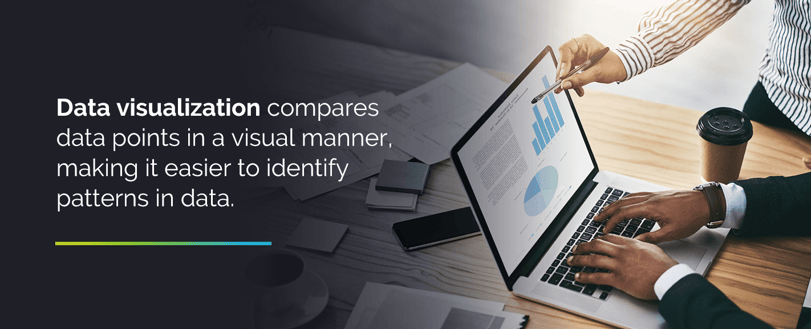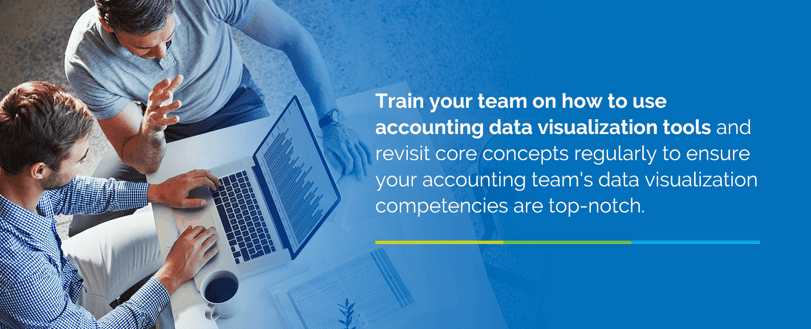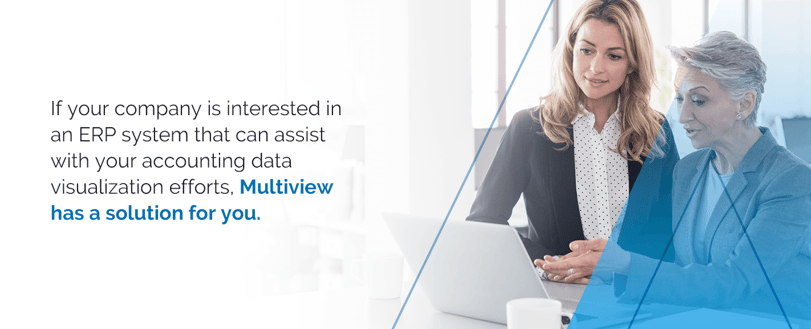“Big data” has revolutionized many aspects of the business world. Nowhere has the change been greater than in the growing field of data visualization.
Cells on spreadsheets are no longer acceptable for presenting data to clients, executives and co-workers. Now, data needs to be packaged and displayed in a way that will make your audience pay attention and take action. It only makes sense, then, that data visualization would spread across businesses, especially in the numbers-focused profession of accounting.
Here’s what accountants need to know about the growing field of data visualization.
What Is Data Visualization?

Data visualization is the practice of converting and presenting data in the form of graphs or other pictorial formats. Some examples of pictorial formats for data include pie charts, maps, bar graphs and line graphs. Data can also be presented in the form of infographics or interactive charts.
These visual representations present significant benefits over raw data, including improved viewer comprehension. They can also express large quantities of data in easily digestible formats, and even create narratives using data. These representations can be used in all aspects of a business, from daily operations to major presentations.
Accounting Data Visualization
Before the days of data visualization, accountants didn’t need to think much about how their data was received. Data presented to audiences was shown as-is, often in spreadsheet or document form. If the viewer didn’t understand the data, that wasn’t the concern of the accounting department.
Additionally, accounting departments only used to focus on a limited pool of data. Their profession mostly dealt with categorizing revenue, expenses and assets correctly and checking work for accuracy. Data from other departments rarely came into play.
Both of these factors changed with the rise of technology and big data. The big data phenomenon has raised expectations for accounting departments, both in processing and presenting data. As a result, data visualization has become a necessity.
Why You Need Data Visualization for Accounting
The days of making accounting clients and co-workers draw conclusions from spreadsheet data alone are long gone. Today, accounting relies as much on visualization as it does on its data. Accountants are expected to convert large quantities of data into easily communicable information that helps people make and support decisions. This is where data visualization comes into play.
For accounting departments, data visualization presents significant benefits in the face of rising client and co-worker expectations. These benefits of data visualization in accounting include:
- Improved comprehension: The most significant advantage of data visualization is its ability to help viewers understand large amounts of data very quickly, even if they are not well-versed in accounting concepts. At one estimate, humans can process images up to 600 times faster than language. This improved comprehension speed is primarily because analyzing a sentence or set of data requires both reading and mental processing. In a visual format, the data is presented in a semi-processed form, requiring less mental processing from the viewer to understand it.
- Faster decision-making: The ability to quickly comprehend visual data also leads to faster and more efficient decision-making processes. In studies, groups using visual language in a meeting increased their ability to reach a consensus by 21% and shortened meetings by 24%. This shows that data visualization can help companies improve efficiency and productivity in decision-making processes.
- Contextualized data: Finance teams can pair accounting data with data from multiple other sources across the business, contextualizing data and patterns. This can help link concepts across the business to check on the company’s overall health. Contextualized data can even assist in creating narratives to help push decisions in a certain direction.
- Pattern identification: Data visualization compares data points in a visual manner, making it easier to identify patterns in data. This can help reveal trends and insights that businesses can use to their advantage.
How to Use Data Visualization in Accounting

Data visualization is a powerful tool that exists in several forms. However, visualization only works when it’s done right. Done poorly, data visualization can cause confusion and even misrepresent your data. When looking into data visualization, accounting departments should keep some essential do’s and don’ts in mind.
Data Visualization Do’s
Accountants and finance experts interested in data visualization need to ensure it enhances their efforts and improves their communication. To do this, they need to keep the following tips in mind:
- Invest in tech: Many tools are available to create visualizations, but not all solutions are created equally. Look for solutions, like enterprise resource planning (ERP) software, that eliminate data silos and offer data visualization tools that simplify visual generation.
- Understand the goal: Dive into the goals you want to accomplish before you create a visual. Determine which sources of data you need and which formats will communicate your ideas most effectively.
- Keep the audience in mind: Know your audience and their level of knowledge before creating data visualizations. More knowledgeable audiences will appreciate more detailed information, while C-level decision-makers will need a high-level overview to help them with strategy without getting lost in the nuances.
- Train users: Effective data visualization creation is a skill, and any skill can be trained. Train your team on how to use accounting data visualization tools and revisit core concepts regularly to ensure your accounting team’s data visualization competencies are top-notch. The more people you train, the more opportunities your team has to spot trends and opportunities for enhancement.
Data Visualization Don’ts
Data visualization efforts can easily misfire when accounting teams don’t take the necessary steps. Some of the common mistakes in data visualization in accounting departments include:
- Insufficient tech: Moving away from spreadsheets requires a collaborative effort within the department, as well as investment in data and visualization solutions. Trying to implement visualization without updating solutions is bound to result in massive inefficiencies, as well as gaps in data.
- Incorrect data: Visualization only works if the data being visualized is accurate and complete. Using bad data can result in the wrong conclusions being drawn, which can lead to misinformed business decisions. Make sure the data your team uses is correct and complete, especially if it is data from other departments.
- Poor design: Finally, a major pitfall in visualization is poor design. From overstuffed charts and unclear data points to poor formatting, design mistakes can result in confusion and miscommunication. Avoid these mistakes by closely considering the goals of each visual and training specialists in the nuances of different visual formats and how to use them effectively.
How ERP Software Can Help With Accounting Data Visualization
The amount of data that accounting teams analyze and visualize has increased tremendously in the past few years. While visualization can help effectively communicate data, the data accountants use to create those visualizations must be accurate, correct and contextual. ERP software is one way to ensure that data meets these goals.
ERP software is an application that collects and analyzes a company’s raw data. ERP solutions warehouse this data and use advanced processing and analysis tools to generate reports and visualizations companies can use to deliver business insights.
ERP solutions are a massive boon for data visualization in many ways. Some of the key benefits of ERP solutions for data visualization include:
- Automated visualization: ERP solutions generate reports and visualizations themselves, which can be used to communicate business concepts across multiple departments.
- Easy access: ERP solutions provide easy-to-access contextual data from multiple departments, which accounting teams can integrate into their own data visualization efforts.
- Updated and accurate data: ERP solutions automatically collect data from software and monitoring solutions across departments, ensuring that data is up-to-date upon collection.
Learn More From Multiview Financial Software

If your company is interested in an ERP system that can assist with your accounting data visualization efforts, Multiview has a solution for you.
The Multiview ERP platform is a comprehensive software suite that leverages technology for your finance teams. Trusted by hundreds of organizations, our platform offers core accounting tools, business insight tools, automation and inventory management capabilities to help your business at all levels.
Watch the KLAS Research Spotlight that conducted interviews with dozens of Multiview clients for their technology spotlight report on Multiview ERP solution.
Request a Multiview ERP demo today to see how this system can benefit your company and accounting department.
Last updated April 13, 2021



